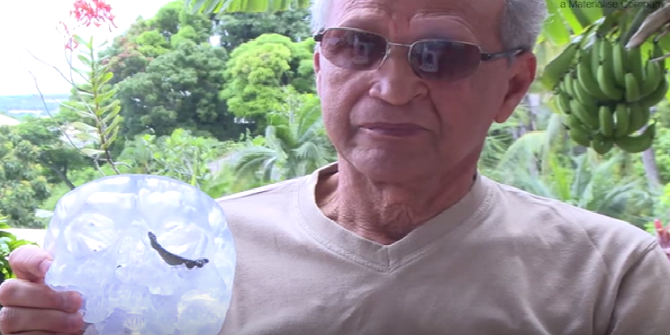The French meteorologist, who previously found relief in sunglasses not just for the glare of the sun, but also for the public eye, has lived on remote islands near Réunion nearly all his life. While life on a small island can be incredibly idyllic as one is able to be in harmony with nature, wildlife, and more–as well as the weather he made a career watching–it can be difficult living in an isolated area, beauty aside. It’s a little more difficult to do many things, living on the outer edges of the real world, settled in the Indian Ocean–just east of the exotic Madagascar–and medical care there decades ago was certainly not on the cutting edge.
“I had a perforation in the orbital floor that left a hole of about two and a half centimeters in diameter,” says Turpin. “The eye had moved down [this far] because there was nothing left to hold the skin, and so when trying to shut it, a sizeable gap remained open.”
“Because of that, I could not sleep at night,” said Turpin. “My eyelid would not close completely and would come in contact with the air, and my eye would always be completely red the next morning.”
Turpin finally made an appointment to get relief for the situation at the office of Dr. Pierre Vives, Head of the Maxillofacial Surgery Department at the University Hospital of La Réunion. The surgeon was able to look for a solution today, although decades ago when Turpin had surgery and dealt with the cancer, there simply was no solution for reconstruction of the orbital wall.
Today, Turpin’s case was still quite complex, and without 3D printing, a solution may not have been found to rectify the pain and irritation the patient was experiencing, not to mention the level of self-consciousness.
“The reconstruction of the bone for this patient was impossible, because of the problem of vascularization, on the one hand, and recovery of the soft tissue on the other,” said Dr. Vives.
“He asked whether I was willing, and I said, ‘let’s go for it,’” Turpin explained.
Dr. Vives doesn’t believe there would have been any other way to pull this surgery off without the 3D printed OBL plate. Part of Materialise since 2007, OBL specializes in patient-specific implants for the cranio-maxillofacial areas. The implants, which they’ve been making through CAD design for over a decade, are 3D printed with a porous titanium material meant to be used in plastic and reconstructive surgeries. Due to the 3D printed titanium plate’s effectiveness, Turpin’s eye is firmly back in place, constant tearing up of the eye has been eliminated–and best of all, he is able to sleep without having to cover the affected area.
“Clearly, this was made possible through a very close collaboration between a surgeon and an engineer,” says Dr. Vives. “Regarding the intervention, an enormous amount of time was saved. This is a surgery that normally would have lasted about a day, and the patient would normally be hospitalized for several days afterward. In this case, Mr. Turpin could leave the hospital the hospital the next day.”
“I immediately realized that the result was good,” says Dr. Vives. “Therefore this is again a surgery that has benefited from using a 3D model for its preparation–a bit like performing a mock-up surgery on a virtual patient.”
The ‘actual’ patient is certainly benefiting from the 3D printed titanium plate and now his hope is that after his surgery was completed and performed successfully, that others in the future will be able to have the same benefits and experience a better quality of life as a result. “That would be a great victory for me,” said Turpin.
Discuss your thoughts on how 3D printing and 3D printed implants and devices are changing the face of medicine in the 3D Printed Titanium Implant forum thread over at 3DPB.com. Check out the video below for details on the experience from Turpin and Dr. Vives.
